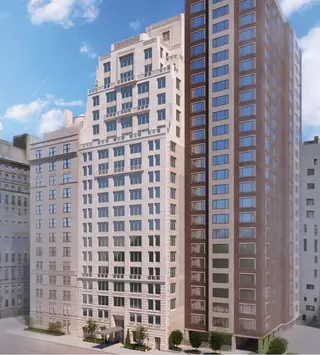 Carter Horsley
Carter HorsleyOct 17, 2017
Carter's Review
This tall, mid-block, rental apartment house has excellent views of Central Park, is close to the Metropolitan Museum of Art and a major crosstown street.
Built in 1968, the 26-story, yellow-brick tower has only 46 apartments.
It was erected by Bernard Spitzer in 1968 and designed by the Office of Michael Schimenti.
Mr. Spitzer also developed another high-rise apartment tower on the avenue, No. 800, on the northeast corner at 61st Street. His other major projects included the Corinthian at 38th Street and First Avenue and 200 Central Park South.
Bottom Line
One of the very few tall apartment towers on Fifth Avenue on the Upper East Side where it is also a rare rental. It is convenient to the Metropolitan Museum of Art.
Description
The tower is almost the same height as another large high-rise apartment house at 980 Fifth Avenue at the northeast corner of 79th Street that replaced an impressive townhouse owned by the Brokaw family and fueled a controversy over the city’s lack at the time of a landmarks preservation law.
980 Fifth Avenue was developed in 1966 by Campagna Construction Corporation.
The 45-unit co-operative building was designed by Paul Resnick and H. F. Green.
The two towers are quite different architecturally but because they are both set back in plazas and are of similar height they are often "read" as one project. The corner building, however, has a gray façade and no balconies while this one has many balconies and its façade has a strong vertical emphasis from its paired, yellow-brick piers.
This tower, which is one of the very few rental residential properties on Fifth Avenue, hides its air-conditioners behind attractive wire grills, a handsome solution that surprisingly, and sadly, has not been employed more often.
While both towers were abrupt intrusions into the stately and palatial elegance of this section of Fifth Avenue they actually compliment one another quite well and their separate plazas read as one. There was, of course, no need for plazas facing Central Park, but the city’s zoning has never been perfect. Being setback mitigates somewhat the noise from the considerable traffic at 79th Street, which is a major transverse road through Central Park.
The sculpture in its plaza is by Priscilla Kabel. Called "The Castle," it had, according to Robert A. M. Stern, Thomas Mellins and David Fishman, the authors of the great "New York 1960, "Architecture and Urbanism Between the Second World War and the Bicentennial" (The Monacelli Press, 1995), "far more architectural charm than the building that constituted its backdrop."
Amenities
The building has a doorman, an elevator person, a live-on superintendent, a fitness center, storage bins, a driveway with sidewalk landscaping and it permits pets.
Apartments
A two-bedroom penthouse duplex unit has a 20-foot-wide curved foyer with a staircase that opens onto a 24-foot-wide living room with a fireplace and a balcony and also onto an 18-foot-long dining room next to the windowed kitchen. The upper level has the master bedroom and an 800-square-foot terrace.
Apartment 19A is a two-bedroom unit with a 12-foot-long marble entry foyer that leads to a 24-foot-long living room with a balcony and a 15-foot-long dining room next to a windowed kitchen.
Apartment 16B is a three-bedroom unit with a 10-foot-long marble entry foyer that leads in one direction to a 24-foot-long living room and in the other to a 19-foot-long dining room next to a 10-foot-long maid’s room and a 12-foot-long, windowed kitchen.
History
In his December 3, 2006 “Streetscapes” article in The New York Times, Christopher Gray provided the following commentary about 985 Fifth Avenue.
“The building was one of four town houses in the Brokaw family complex. Isaac Vail Brokaw, a clothing merchant and member of one of New York’s oldest families, put up a wonderfully muscular little chateau designed by Rose & Stone for the northeast corner of 79th Street and Fifth Avenue in the late 1880s.
“In 1906, Mr. Brokaw built twin neo-Gothic houses just north of his house, at 984 and 985 Fifth Avenue, for his sons Howard and Irving. Designed by Charles Rose, one of the architects for the original Brokaw house, these were more heavily ornamented - and therefore more conventional - than the chastely modest original house.
“The 1910 census found Irving Brokaw, a skating champion, living at No. 985 with his family of four, who were served by a household staff of 11 from England, Scotland, Ireland, Norway, France, Germany, Switzerland and Hungary.
“As for Howard Brokaw, it appears that he ran the family business, while Irving, although trained as a lawyer, was committed to the sport of figure skating. In the year their houses were completed, Irving won the national amateur figure skating championship, which he had tried to win four times previously.
“In 1914, a fourth Brokaw house, 5 East 79th Street, was built for a married daughter, Elvira McNair.
“The Brokaws had moved on by 1964 when pickets protested the demolition of the corner house, 5 East 79th and 984 Fifth, to make way for the apartment building known as 980 Fifth Avenue. But the owner, the Campagna Construction Corporation, persisted; preservationists were as unsuccessful as they had been with their campaign to save Pennsylvania Station the year before. The loss of the Brokaw corner is considered a prelude to the signing of the Landmarks Law in 1965.”

- Condo built in Planned for 2027
- 1 apartment currently for rent ($25K)
- Located in Carnegie Hill
- 26 total apartments 26 total apartments
- Doorman
- Pets Allowed

 6sqft delivers the latest on real estate, architecture, and design, straight from New York City.
6sqft delivers the latest on real estate, architecture, and design, straight from New York City.
